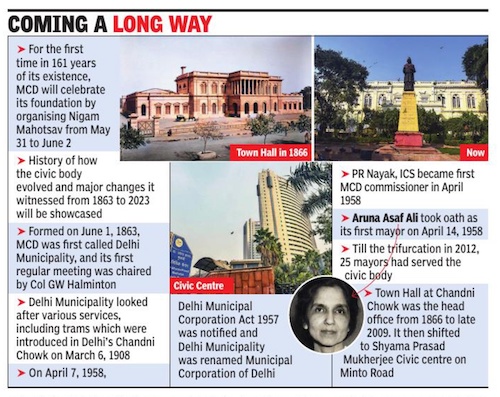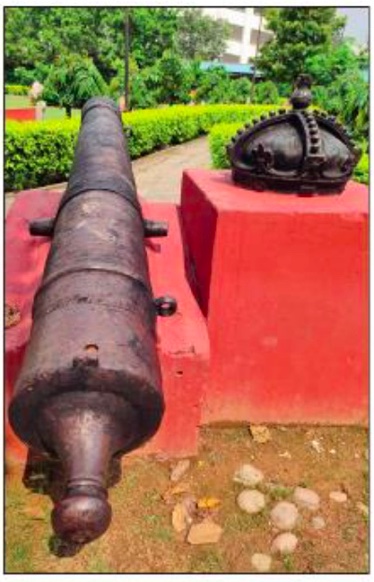Municipal Corporation of Delhi
This is a collection of articles archived for the excellence of their content. |
Contents |
A backgrounder
History
Vibha Sharma, March 17, 2024: The Times of India

From: Vibha Sharma, March 17, 2024: The Times of India
Called Delhi Municipality when it was formed on June 1, 1863, it held its first regular meeting under the chairmanship of colonel GW Hamilton, after whom a road near Old Delhi Railway Station is named.
“Delhi Municipality’s role was limited to the Shahjahanabad area. Other parts of the city had 13 such bodies or committees. For example, there was something called the Notified Area Committee for Red Fort and similar notified area committees for Shahdara, Mehrauli, Najafgarh, Civil Station and municipal committees for west and south Delhi,” revealed an MCD official.
After independence, in 1957, all these committees were consolidated into one body called the Delhi Municipal Corporation. A bill was tabled in Parliament on Nov 11, 1957, by the then Union home minister Govind Ballabh Pant. On April 7, 1958, the legislation was notified as the Delhi Municipal Corporation Act, 1957.
PR Nayak, an Indian Civil Service officer, was appointed the first commissioner of MCD in April 1958 and he continued till 1960. “He had a lot of experience, having served as Bombay Municipal Corporation commissioner earlier,” said the official. MCD was trifurcated into three bodies in Jan 2012 and again reunified in May 2022.
Services provided by MCD
In 1863, the role of the municipality was more than just sanitation. It also looked after fire services, water supply, transport, electricity, primary health services, etc. The MCD official said, “Delhi Municipality even managed the trams that were introduced in Chandni Chowk on March 6, 1908, at the behest of the viceroy, Lord Hardinge, who inaugurated the Tramway Company’s project at Town Hall.”
After independence, MCD continued to be responsible for the majority of civic services in Delhi, including sewerage, water, health and bus service. In fact, after the promulgation of the DMC Act, the Delhi State Electricity Board formed in 1951 was dissol- ved and its functions taken over by Delhi Electric Supply Undertaking, which came into existence in 1958 and was part of MCD. But as the city expanded and its demand increased, new bodies were created to look after specific service. “In 1972, MCD was divested of transport through an ordinance and Delhi Transport Corporation was formed. Then, in 1996-97, Delhi Jal Board was formed. In Feb 1997, Delhi govt constituted Delhi Vidyut Board for generation and distribution of power in the capital. The ad- ministrative control of Delhi Fire Service, previously with MCD, was passed to the state govt on Nov 10, 1994,” said the official.
The march of mayors
Freedom fighter Aruna Asaf Ali took oath as first mayor of MCD on April 14, 1958. Her portrait still adorns the chambers of the old municipal House at Town Hall and at the offices at the current headquarters, Civic Centre. A prominent street in the city was also named after her. Ali was mayor till May 31, 1959, when Trilok Chand Sharma succeeded her. He took oath on June 24, 1959 and his term was till April 5, 1960.
Prior to the trifurcation of MCD in 2012, there were 25 mayors of the civic body. The last was law scholar Rajni Abbi from April 20, 2011 to April 30, 2012. A little over a decade after the trifurcation, another woman, Shelly Oberoi, is again at the helm following the unification of the municipality in May 2022.
Iconic Town Hall
Town Hall, the municipal building for a long time, is a landmark structure in Chandni Chowk. It was the office of Delhi Municipality from 1866 during the British era till late 2009, when the headquarters was shifted to the new high-rise Civic Centre on Minto Road.
“The British constructed town halls in most Indian cities. These were places not only for meetings where town development decisions were taken, but also for social gatherings. The construction of Delhi Town Hall took place from 1861 to 1866 at a spot where there once existed a garden and sarai created by Jahanara, daughter of Mughal emperor Shahjahan. The building was built in red and white colours initially with the main entrance from Chandni Chowk,” said the official.
Town Hall actually began as the Delhi Institute on its foundation in 1861 and housed the Delhi College of Higher Studies before its purchase in 1866 by the then municipality for Rs 1,35,457.
Till the beginning of the 1900s, a stone elephant stood at the entrance of Town Hall. After the death of Queen Victoria in 1901, a bronze statue of the monarch replaced it. The formation of MCD led to the replacement of the queen’s statue by that of Arya Samaj leader Swami Shraddhanand.
As in 2022

From: Dec 8, 2022: The Times of India
See graphic:
Municipal Corporation of Delhi, a brief introduction
Artefacts
Vibha Sharma, March 17, 2024: The Times of India

From: Vibha Sharma, March 17, 2024: The Times of India
New Delhi: The printing press next to Town Hall in old Delhi and constructed in the 1940s will be developed into a museum to display souvenirs, visitors’ books signed by dignitaries, artefacts and printing machines such as the one purchased in 1926 from England. The Municipal Corporation of Delhi has signed one MoU with the Indira Gandhi National Centre for the Arts for conserving these artefacts and digitalising the rare documents and a second MoU on consultancy in setting up the museum in what was called Press Building.
“The visitors’ book was signed by premier Chou En Lai of China in 1957, Dr Rajendra Prasad, the last king of Afghanistan Mohammad Zahir Shah and prime minister of Vietnam Ho Chi Minh all in 1958, by Edwina Mountbatten in 1959, Queen Elizabeth II and Prince Philip in Jan 1961 and many other historical personalities,” said an MCD official. The plan is to preserve the historical documents and put them on display for the general public. There are house proceedings from 1878, including decisions that highlight the developments in Delhi. “Another highlight of the museum will be video clips such as one from 1958 when Dr Rajendra Prasad visited the building in a beautiful horse carriage. He was invited by the then mayor to Town Hall,” the official said. On display will be revenue stamps, postal stamps from 1902 onwards, maps of Delhi, Wilson’s Survey Report (191011) with its significant compilation of maps and drawings of Shahjahanabad, paintings, photographs, felicitations, a cannon from 1709, a 1940s crown, souvenirs gifted by guests, newspapers, letters and interesting public notices issued by Delhi Municipality and MCD’s health department such as the one issued in the 1930s specifying the permissible marriageable age for men as 18 and women as 14 years. There also are six vintage printing machines, including one bought for Rs 1,200 from England in 1926, a wire stitching machine from USA in 1954, a cylinder Elliot printing machine from 1950 and an original Perfecta printing machine bought from Germany in 1956 at Rs 27,740.
The impressive Press Building, once the office of the municipal magistrate and the press, can now become a tourist attraction. “Town Hall also has important books and artefacts that will now be conserved. They will help reveal interesting facts about Delhi’s history,” said Achal Pandya, head, conservation, IGNCA.
She added, “Town Hall, once the seat of Delhi’s municipal corporation, is an emblem of the city’s heritage and history. Now vacated because it is too small to meet current requirements, the building holds memories of countless dignitaries who graced its halls. With MCD and IGNCA collaborating on conservation, it has the potential to transform into a vibrant cultural space with artifacts revealing the intriguing chapters of Delhi’s past.”
Administrative structure
As in 2023
February 24, 2023: The Times of India
Mayor | As the head of the deliberative wing of the Municipal Corporation of Delhi, the mayor’s role is akin to that of the assembly Speaker. The mayor, who chairs the proceedings of the House, gets discretionary funds and other facilities, and has the power to grant anticipatory approvals to proposals. He/she has full access to all records of the corporation and may seek a report from the commissioner on any matter connected with municipal governance.
Commissioner | The commissioner is the bureaucratic head of MCD and oversees the implementation of its policies and programmes. He/she prescribes the duties and supervises the work of all municipal officers, other than the municipal secretary and the chief auditor.
Standing Committee | The Standing Committee comprises six members elected by the councillors at the House’s first meeting and 12 others, one each from the zonal/ ward committees. These members can have a maximum term of two years. The retired members can, however, recontest the polls. Together, the Standing Committee is empowered to take decisions on all financial matters and appointments. House/corporation | The final sanction of funds, to be spent in the same financial year, for different projects comes from the House. The corporation may, at any time, call for records of the proceedings of the standing/wards/other committees. It can also ask the commissioner to furnish records, correspondence, plans or other documents in his possession or under his control.
WHY THE RUCKUS OVER ELECTION OF STANDING COMMITTEE MEMBERS
With the Standing Committee empowered to take decision on all financial matters, its role is pivotal. The budget estimates, for one, require the approval of the Standing Committee. Any alteration in the proposals need the nod of the Standing Committee. Even the commissioner requires the committee’s nod for various financial operations. For example, no contract that involves an expenditure exceeding an amount higher than permitted by the Centre from time to time, can be made by the commissioner unless the same is previously approved by the Standing Committee. All proposals are first approved by the committee before being placed in the House. The party having a majority in the Standing Committee will automatically have the say on all financial matters